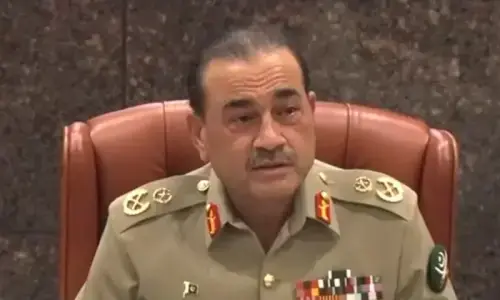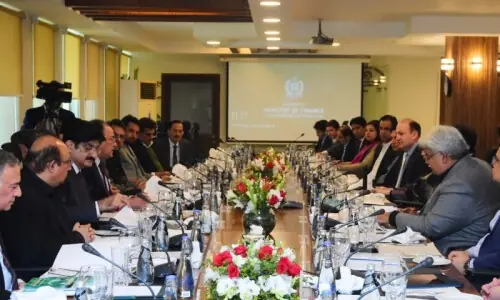LAHORE: It is not uncommon to hear many deny that the visible and stinky haze hanging in Lahore’s air could be smog – despite the glut of news around smog in the Punjab. Those who do accept that the yellowish particulate matter suspended before them is indeed hazardous also suggest that this ‘smog’ is somehow a natural and perennial phenomenon that one must accept, and be comforted that at some point nature will take its course and wash the city clean.
Yet Lahore’s smog situation is a symptom of a much larger air pollution crisis which is persistent and toxic even when invisible to the naked eye. Although the sources of the pollution vary, most of them are contributing compounding quantities of dangerous particulate matter into the atmosphere year after year. What this means is that, even after rain or a windstorm carries away the pollutants that are irritating our eyes, lungs and throats, more pollutants will continue to be pumped into the air in and around our communities throughout the rest of the year, detrimentally continuing to affect our health as well as contributing to the cumulative greenhouse gases in the atmosphere that worsen global warming.
In other words, the few autumn weeks during which the smog events seem to be occurring annually, is not the only time we should be concerned about the quality of the air we are breathing. According to the State of Global Air 2017 report on global exposure to air pollution and its disease burden, conducted by the Health Effects Institute in Boston, Pakistan’s air quality has consistently been worsening for years, causing an estimated 135,000 deaths in 2015. This was the case even though the air pollution was not highly perceptible by sight and smell that year.
Few air quality monitors are operating in Lahore so it is difficult to know the full extent to which the province’s air quality standards are being met or what the trends of local emissions even are. Oddly, while downplaying the agency’s inability to adequately enforce environmental standards, the EPD stresses the need for air quality monitoring equipment in order to ascertain what/who is responsible for producing the recurrent smog waves. Yet, environmental lawyer Ahmad Rafay Alam was recently quoted on social media saying that he personally observed that many of the new monitors procured by the provincial government since last year’s smog wave remain unopened in the Punjab EPD office.
Whether the government monitors are operating or not, data provided by academic studies and community-driven air quality reports of the Pakistan Air Quality Initiative illustrate the trend of steadily worsening air quality in Lahore, as well as across all of Pakistan. Such reports make it clear that the sources of Lahore’s air pollution are not mysterious, but in fact are already widely known and well understood.
The mushrooming number of vehicles on the roads is one major source of air pollution, with the nearly 4 million vehicles registered in Punjab in 2005 climbing to over 13 million by 2014. The growing quantity of dust in the air from massive infrastructure/housing scheme construction is another source, as is tree-cutting, which reduces the amount of CO2 being taken up by these plants and worsens soil erosion. Of course, there is also the smoke that is pumped into the air daily by the unregulated polluting factories. Other sources include incineration of growing quantities of garbage, burning of crop residues by farmers on both sides of the border, prevalent use of diesel-burning generators, and the growth of fossil fuel-based power plants, known for emitting toxic greenhouse gases.
While various government departments are legally bound to safeguard the health of the public and the environment, it is common knowledge that existing environmental legislation is not taken seriously. Therefore it comes as little surprise to see that the Punjab EPD’s new ‘Policy on Controlling Smog 2017’, a propaganda video tweeted by the Government of Punjab, as well as comments by the Minister of the Environment, Zakia Shah Nawaz, all shift a disproportionate amount of blame for the air pollution crisis onto Indian farmers burning their agricultural residues.
Where the government does claim to be taking measures to reduce locally produced pollution, its approaches appear to be ridden with inconsistencies. For instance, the new smog policy places a ban on the burning of solid waste, agricultural residues, and hazardous waste. It is not yet clear how responsive LWMC and local authorities have been in curbing these crimes, as burning solid waste has been illegal for years, during which time residents say that trash burning has been a common practice even carried out by LWMC itself. Without a long-term plan to provide non-hazardous and ecologically sustainable ways to deal with the wastes, as well as to create incentives for farmers to manually deal with the agricultural residue, many remain skeptical as to whether the authorities intend to carry out their mandate.
Failures in the power grid are being attributed to the smog, some allegedly due to trips on the power line, while other supply shortfalls are due to scheduled maintenance work. Prime Minister Shahid Khaqan Abbasi issued an edict on Friday to the power board telling them to shut down furnace oil and diesel-based power plants due to the smog, but this appears to be a temporary measure, as some of the power plants have already resumed operations. At the same time, no serious effort is being made toward transitioning the country’s polluting and prone-to-failure energy systems to those that are ecologically sustainable, non-polluting, non-hazardous sources. Instead the government has committed itself to continuing to burn fossil fuels, including the dirtiest of them all, coal.
Speaking at a workshop on Air Pollution and Smog at the University of Veterinary and Animal Sciences on Wednesday, Zia ul Islam, programme manager of the National Ozone Unit under the Ministry of Climate Change, said, “If we don’t address the air quality problems, the world will not forgive us.”
Sadly, the temporary and insufficient approaches being taken will not address the destructive and dangerous occurrence of smog, nor the persistent air pollution crisis Pakistan is facing, nor the larger ecological and social woes of the century. As long as the country remains committed to the failed Western model of development, or the Chinese variant, both operating according to the flawed logic of endlessly chasing an elusive ‘growth’ at all costs and both responsible for literally destroying lives and the planet, prospects in the foreseeable future for a liveable Lahore, and in much of the world, will remain increasingly dubious.
The only way out of this abyss is by addressing the air pollution crisis in lock-step with meaningful and coordinated strategies to provide a path for all Lahoris to have clean, affordable and safe transport, housing, schools, water, and electricity, which will require creating an underlying logic that prioritises the needs of people and the planet over private gain.
(The writer is a doctoral student of Built Environment and Development Studies at the University of KwaZulu Natal, South Africa, and a researcher at the Lahore School of Economics)
Published in Dawn, November 9th, 2017




































